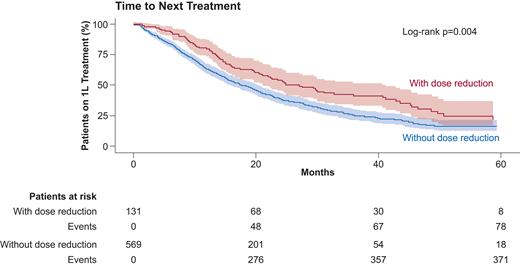Background: Ibrutinib (Ibr) has demonstrated a significant progression-free survival and overall survival benefit compared to chemotherapy in multiple phase 3 studies in patients with previously untreated and relapsed/refractory chronic lymphocytic leukemia (CLL)/small lymphocytic lymphoma (SLL). Patients with CLL/SLL who continue treatment with single-agent Ibr experience better survival outcomes than those who discontinue treatment within the first 2 years. Adverse events (AEs) may be managed, and treatment outcomes are optimized through Ibr dose reduction (DR). Recent real-world data have shown that patients with a DR after an AE had longer time to next treatment (TTNT) than those without a DR and that this trend was consistent among patients with cardiac and noncardiac AEs (Shadman et al, EHA 2023). Here we continue to evaluate the impact of DR on real-world outcomes using data from electronic medical records (EMRs).
Aims: This study estimates the real-world impact of DR following an AE among patients with CLL/SLL.
Methods: Previously untreated adults diagnosed with CLL/SLL on or after February 12, 2013), who were treated with 420 mg single-agent Ibr on or after Feb 12, 2014 (Ibr approval date) were analyzed using EMRs from the ConcertAI database (February 12, 2013−May 1, 2022). Patients were included if they had a cardiac or noncardiac AE after single-agent Ibr initiation at 420 mg per day without any DRs/escalations prior to first AE occurrence (index date). Patients were excluded if they received an antineoplastic agent ≤6 months prior to starting first-line (1L) Ibr, an antineoplastic agent or combination therapy within 28 days of Ibr use, second-line therapy within 30 days of index, hematopoietic stem cell transplant, CYP3A inhibitor during 1L Ibr or before start of the second-line, an experimental therapy in clinical trials, or were diagnosed with other malignancies for which Ibr is indicated within 6 months prior to Ibr initiation. Demographics, clinical characteristics, and TTNT were described following AE occurrence among patients with and without DRs. A DR was defined as a dose lower than 420 mg per day on or after the date of first AE post-Ibr initiation, per pharmacy records. Cardiac AEs included atrial fibrillation, ischemic heart disease, heart failure, hypertension, and cardiomyopathy. Noncardiac AEs included febrile neutropenia, anemia, neutropenia, pancytopenia, thrombocytopenia, diarrhea, abdominal pain, musculoskeletal pain, rash, and pneumonia. TTNT sensitivity analyses requiring next-line treatment to occur ≥180 days after 1L initiation or considering a switch to another BTKi or death as censoring events were also conducted.
Results : Overall, 522 patients were included in the analysis; 420 patients (80%) without a DR and 102 patients (20%) with a DR. Patients with a DR were slightly older than those without (median age: 74.5 vs 70 years); a lower proportion of women had a DR compared with men (43% vs 57%). Among patients with and without a DR, the median time to the first incident AE was 42 days and 65 days, respectively. Among patients with a DR, 68 (67%) were able to resume the full 420 mg per day Ibr dose after DR. Mean time between Ibr initiation and end of 1L Ibr treatment was significantly longer in patients with a DR compared with those without (553 days vs 464 days; P = 0.012). Fewer patients with DR had a next treatment (47%) than those without a DR (55%). Median TTNT was significantly longer in patients with DR (27 months, 95% CI: 21, 44) compared with those without (18 months, 95% CI: 15, 20) ( P = 0.007) (Figure). TTNT results were similar in each sensitivity analysis.
Summary/Conclusion: Among patients with CLL/SLL treated with 1L Ibr, those with doses reduced after experiencing an AE remained on 1L Ibr longer compared with those who did not have the dose reduced. Ibr dose adjustments may support patients with CLL/SLL remaining on 1L Ibr longer.
Disclosures
Shadman:Genmab: Consultancy, Research Funding; BeiGene: Consultancy, Research Funding; ADC therapeutics: Consultancy; Mustang Bio: Consultancy, Research Funding; Bristol Myers Squibb: Consultancy, Research Funding; MorphoSys/Incyte: Consultancy, Research Funding; Vincerx: Research Funding; Pharmacyclics: Consultancy, Research Funding; Janssen: Consultancy; Fate Therapeutics: Consultancy; Kite, a Gilead Company: Consultancy; Eli Lilly: Consultancy; AstraZeneca: Consultancy, Research Funding; Genentech: Consultancy, Research Funding; AbbVie: Consultancy, Research Funding; MEI Pharma: Consultancy; Regeneron: Consultancy; TG Therapeutics: Research Funding. Karve:AbbVie: Current Employment, Current holder of stock options in a privately-held company. Patel:AbbVie: Current Employment, Divested equity in a private or publicly-traded company in the past 24 months. Rava:Alexion, AstraZeneca: Research Funding; Genesis Research: Current Employment. Sun:Genesis Research: Current Employment; AbbVie: Research Funding. Howarth:Genesis Research: Current Employment; AbbVie: Research Funding. Tomicki:Genesis Research: Current Employment; AbbVie: Consultancy. Srivastava:Abbvie: Current Employment, Current equity holder in publicly-traded company; Jazz Pharmaceuticals: Current equity holder in publicly-traded company. Stephens:AbbVie: Consultancy; AstraZeneca: Consultancy, Research Funding; BeiGene: Consultancy; Bristol-Myers Squibb: Consultancy; Celgene: Consultancy; Genentech: Consultancy; Janssen: Consultancy; Lilly: Consultancy; Novartis: Research Funding.


This feature is available to Subscribers Only
Sign In or Create an Account Close Modal